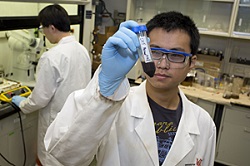 That hot cup of Joe in the morning could become more than just a jolt to get your body going; it could be the next tankful of biodiesel to get your vehicle going. Researchers at the University of Cincinnati are figuring out how to turn old coffee grounds into biodiesel, and Yang Liu, from the school’s College of Engineering and Applied Science (CEAS), will present his findings at the American Chemical Society’s (ACS) 246th National Meeting & Exposition this week in Indianapolis.
That hot cup of Joe in the morning could become more than just a jolt to get your body going; it could be the next tankful of biodiesel to get your vehicle going. Researchers at the University of Cincinnati are figuring out how to turn old coffee grounds into biodiesel, and Yang Liu, from the school’s College of Engineering and Applied Science (CEAS), will present his findings at the American Chemical Society’s (ACS) 246th National Meeting & Exposition this week in Indianapolis.
Liu and fellow researchers Qingshi Tu, a UC doctoral student in environmental engineering, and Mingming Lu, a UC associate professor of environmental engineering, used a three-pronged approach to converting waste coffee grounds into energy sources including biodiesel and activated carbon by:
Extracting oil from the waste.
Drying the waste coffee grounds after oil removal to filter impurities in biodiesel production.
Burning what was left as an alternative energy source for electricity, similar to using biomass.
The researchers launched the project in 2010, gathering waste coffee grounds in a five-gallon bucket from a Starbucks store on UC’s campus. After collection, they removed the oil from the waste coffee grounds and converted triglycerides (oil) into biodiesel and the byproduct, glycerin. The coffee grounds were then dried and used to purify the biodiesel they derived from the waste coffee grounds.
The researchers found that the oil content in the waste coffee grounds was between about 8 and 20 percent, while making a biodiesel that meets the ASTM International D6751 standard.

